Electrode Setup for Electromyography-Based Silent Speech Interfaces: A Pilot Study
Abstract
1. Introduction
| Reference | Electrode Number and Type | Locations |
|---|---|---|
| Chan et al. (2001, 2002) [13,14] | 5 pairs | LAO, ZYG, PLT, DAO, ABD |
| Maier-Hein et al. (2005) [15] | 7 pairs (3 bipolar, 4 monopolar) | LAO, ZYG, PLT, DAO, ABD, Tongue |
| Jou et al. (2006) [16] | 6 pairs (2 bipolar, 4 monopolar) | LAO, ZYG, PLT, ABD, Tongue |
| Schultz and Wand (2010) [17]; Wand and Schultz (2011) [18] | 5 pairs (2 bipolar, 3 monopolar) | LAO, ZYG, PLT, ABD, Tongue |
| Diener et al. (2015) [19]; Diener (2021) [20] | 5 pairs (2 bipolar, 3 monopolar) | LAO, ZYG, PLT, ABD, Tongue |
| Mostafa et al. (2016) [21] | 3 electrodes | MAS, BUC, Depressor |
| Soon et al. (2017) [22] | 1 pair | OBO |
| Ma et al. (2019) [23] | 2 monopolar electrodes, 2 bipolar pairs | RIS, ABD, LIN, LAO |
| Wang et al. (2021) [24] | 4 pairs | LAO, DAO, BUC, ABD |
| Wu et al. (2022) [25] | 6 pairs | MNT, RIS, LLS, ABD, MLH, PLT |
| Li et al. (2023) [26] | 6 tripolar | OBO, MAS, lower lip muscle, bi-abdominal anterior abdomen, inferior lateral muscle of the hyoid bone, SCM |
| Meltzner et al. (2008) [27]; Colby et al. (2009) [28] | 11 bipolar bars | supralabial, labial, sublabial, submental neck, midline neck, lateral neck |
| Meltzner et al. (2011) [29] | 8 single-differential bars | submental neck, ventromedial neck, supralabial face, infralabial face |
| Deng et al. (2014) [30] | 4 sensors | above and below the oral commissure, submental surface, ventral neck surface |
| Meltzner et al. (2017) [31] | 8 differential bars | submental, ventromedial, supralabial, infralabial |
| Meltzner et al. (2018) [32] | 11 sensors | submental region, ventral neck, face |
| Gaddy and Klein (2020, 2021) [33,34]; Gaddy (2022) [35] | 8 monopolar electrodes | left cheek just above mouth, left corner of chin, below chin back 3 cm, throat 3 cm left from Adam’s apple, mid-jaw right, right cheek just below mouth, right cheek 2 cm from nose, back of right cheek; 4 cm in front of ear |
| Wand et al. (2013) [36] | two 1 × 8 strips | cheek, chin |
| Wand et al. (2013) [36]; Diener et al. (2015) [19]; Diener (2021) [20] | 4 × 8 grid, 1 × 8 strip | cheek, chin |
| Zhu et al. (2019, 2020, 2021) [37,38,41]; Wang et al. (2020, 2021) [39,40] | 120 high-density electrodes | cheeks, neck |
| Deng et al. (2023) [42] | 8 electrodes within two 32-channel arrays | ZYG, RIS, DAO, SCM, ABD, PLT |
2. Materials and Methods
2.1. Data Collection
2.2. Signal Processing and Feature Extraction
2.3. Experiments
2.4. Evaluation
3. Results
3.1. Electrode Type
3.2. Channel Selection
4. Discussion
Author Contributions
Funding
Institutional Review Board Statement
Informed Consent Statement
Data Availability Statement
Acknowledgments
Conflicts of Interest
Abbreviations
| ABD | anterior belly of the digastric |
| BUC | buccinator |
| CV | consonant-vowel |
| DAO | depressor anguli oris |
| DLI | depressor labii inferioris |
| DT | decision trees |
| EMG | electromyography |
| FRT | frontalis |
| GMM | Gaussian mixture model |
| LAO | levator anguli oris |
| LDA | linear discriminant analysis |
| LLS | levator labii superioris |
| MAS | masseter |
| MLH | mylohyoid |
| MNT | mentalis |
| NN | neural network |
| OBO | orbicularis oris |
| PBD | posterior belly of the digastric |
| PLT | platysma |
| PSD | power spectral density |
| RIS | risorius |
| SBO | superior belly of the omohyoid |
| SCM | sternocleidomastoid |
| SLH | stylohyoid |
| SSI | silent speech interface |
| STR | sternothyroid |
| TD | time-domain |
| ZYG | zygomaticus major |
Appendix A

References
- Weinberg, B. Acoustical Properties of Esophageal and Tracheoesophageal Speech. In Laryngectomee Rehabilitation; College Hill Press: San Diego, CA, USA, 1986; pp. 113–127. [Google Scholar]
- Most, T.; Tobin, Y.; Mimran, R.C. Acoustic and Perceptual Characteristics of Esophageal and Tracheoesophageal Speech Production. J. Commun. Disord. 2000, 33, 165–181. [Google Scholar] [CrossRef] [PubMed]
- Tang, C.G.; Sinclair, C.F. Voice Restoration After Total Laryngectomy. Otolaryngol. Clin. N. Am. 2015, 48, 687–702. [Google Scholar] [CrossRef] [PubMed]
- Bell, R.B.; Andersen, P.; Fernandes, R. Oral, Head and Neck Oncology and Reconstructive Surgery, 1st ed.; Elsevier: Amsterdam, The Netherlands, 2016. [Google Scholar]
- Denby, B.; Schultz, T.; Honda, K.; Hueber, T.; Gilbert, J.M.; Brumberg, J.S. Silent Speech Interfaces. Speech Commun. 2010, 52, 270–287. [Google Scholar] [CrossRef]
- Freitas, J.; Teixeira, A.; Dias, M.S.; Silva, S. An Introduction to Silent Speech Interfaces; Springer: Cham, Switzerland, 2016. [Google Scholar]
- Gonzalez-Lopez, J.A.; Gomez-Alanis, A.; Martin Donas, J.M.; Perez-Cordoba, J.L.; Gomez, A.M. Silent Speech Interfaces for Speech Restoration: A Review. IEEE Access 2020, 8, 177995–178021. [Google Scholar] [CrossRef]
- Vojtech, J.M.; Stepp, C.E. Electromyography. In Manual of Clinical Phonetics, 1st ed.; Ball, M.J., Ed.; Routledge: London, UK, 2021; pp. 248–263. [Google Scholar] [CrossRef]
- Kim, M.; Sebkhi, N.; Cao, B.; Ghovanloo, M.; Wang, J. Preliminary test of a wireless magnetic tongue tracking system for silent speech interface. In Proceedings of the 2018 IEEE Biomedical Circuits and Systems Conference (BioCAS), Cleveland, OH, USA, 17–19 October 2018; pp. 1–4. [Google Scholar]
- Gilbert, J.M.; Gonzalez, J.A.; Cheah, L.A.; Ell, S.R.; Green, P.; Moore, R.K.; Holdsworth, E. Restoring speech following total removal of the larynx by a learned transformation from sensor data to acoustics. J. Acoust. Soc. Am. 2017, 141, EL307–EL313. [Google Scholar] [CrossRef]
- Hernaez, I.; González-López, J.A.; Navas, E.; Pérez Córdoba, J.L.; Saratxaga, I.; Olivares, G.; Sánchez de la Fuente, J.; Galdón, A.; García Romillo, V.; González-Atienza, M.; et al. Voice Restoration with Silent Speech Interfaces (ReSSInt). In Proceedings of the IberSPEECH 2021, Valladolid, Spain, 24–25 March 2021; pp. 130–134. [Google Scholar] [CrossRef]
- Hernaez, I.; Gonzalez Lopez, J.A.; Navas, E.; Pérez Córdoba, J.L.; Saratxaga, I.; Olivares, G.; Sanchez de la Fuente, J.; Galdón, A.; Garcia, V.; del Castillo, J.; et al. ReSSInt Project: Voice Restoration Using Silent Speech Interfaces. In Proceedings of the IberSPEECH 2022, Granada, Spain, 14–16 November 2022; pp. 226–230. [Google Scholar] [CrossRef]
- Chan, A.D.C.; Englehart, K.; Hudgins, B.; Lovely, D.F. Myo-Electric Signals to Augment Speech Recognition. Med. Biol. Eng. Comput. 2001, 39, 500–504. [Google Scholar] [CrossRef]
- Chan, A.; Englehart, K.; Hudgins, B.; Lovely, D. Hidden Markov Model Classification of Myoelectric Signals in Speech. IEEE Eng. Med. Biol. Mag. 2002, 21, 143–146. [Google Scholar] [CrossRef]
- Maier-Hein, L.; Metze, F.; Schultz, T.; Waibel, A. Session Independent Non-Audible Speech Recognition Using Surface Electromyography. In Proceedings of the IEEE Workshop on Automatic Speech Recognition and Understanding, Cancun, Mexico, 27 November–1 December 2005; pp. 331–336. [Google Scholar] [CrossRef]
- Jou, S.C.; Schultz, T.; Walliczek, M.; Kraft, F.; Waibel, A. Towards continuous speech recognition using surface electromyography. In Proceedings of the Ninth International Conference on Spoken Language Processing, Pittsburgh, PA, USA, 17–21 September 2006. [Google Scholar]
- Schultz, T.; Wand, M. Modeling Coarticulation in EMG-based Continuous Speech Recognition. Speech Commun. 2010, 52, 341–353. [Google Scholar] [CrossRef]
- Wand, M.; Schultz, T. Analysis of Phone Confusion in EMG-based Speech Recognition. In Proceedings of the 2011 IEEE International Conference on Acoustics, Speech and Signal Processing (ICASSP), Prague, Czech Republic, 22–27 May 2011; pp. 757–760. [Google Scholar] [CrossRef]
- Diener, L.; Janke, M.; Schultz, T. Direct Conversion from Facial Myoelectric Signals to Speech Using Deep Neural Networks. In Proceedings of the 2015 International Joint Conference on Neural Networks (IJCNN), Killarney, Ireland, 12–17 July 2015; pp. 1–7. [Google Scholar] [CrossRef]
- Diener, L. The Impact of Audible Feedback on EMG-to-Speech Conversion. Ph.D. Thesis, University of Bremen, Bremen, Germany, 2021. [Google Scholar]
- Mostafa, S.S.; Awal, M.A.; Ahmad, M.; Rashid, M.A. Voiceless Bangla Vowel Recognition Using sEMG Signal. SpringerPlus 2016, 5, 1522. [Google Scholar] [CrossRef][Green Version]
- Soon, M.W.; Anuar, M.I.H.; Abidin, M.H.Z.; Azaman, A.S.; Noor, N.M. Speech Recognition Using Facial sEMG. In Proceedings of the 2017 IEEE International Conference on Signal and Image Processing Applications (ICSIPA), Kuching, Malaysia, 12–14 September 2017; pp. 1–5. [Google Scholar] [CrossRef]
- Ma, S.; Jin, D.; Zhang, M.; Zhang, B.; Wang, Y.; Li, G.; Yang, M. Silent Speech Recognition Based on Surface Electromyography. In Proceedings of the 2019 Chinese Automation Congress (CAC), Hangzhou, China, 22–24 November 2019; pp. 4497–4501. [Google Scholar] [CrossRef]
- Wang, Y.; Tang, T.; Xu, Y.; Bai, Y.; Yin, L.; Li, G.; Zhang, H.; Liu, H.; Huang, Y. All-Weather, Natural Silent Speech Recognition via Machine-Learning-Assisted Tattoo-like Electronics. Npj Flex. Electron. 2021, 5, 20. [Google Scholar] [CrossRef]
- Wu, J.; Zhang, Y.; Xie, L.; Yan, Y.; Zhang, X.; Liu, S.; An, X.; Yin, E.; Ming, D. A Novel Silent Speech Recognition Approach Based on Parallel Inception Convolutional Neural Network and Mel Frequency Spectral Coefficient. Front. Neurorobot. 2022, 16, 971446. [Google Scholar] [CrossRef] [PubMed]
- Li, W.; Yuan, J.; Zhang, L.; Cui, J.; Wang, X.; Li, H. sEMG-based Technology for Silent Voice Recognition. Comput. Biol. Med. 2023, 152, 106336. [Google Scholar] [CrossRef] [PubMed]
- Meltzner, G.S.; Sroka, J.; Heaton, J.T.; Gilmore, L.D.; Colby, G.; Roy, S.; Chen, N.; Luca, C.J.D. Speech Recognition for Vocalized and Subvocal Modes of Production Using Surface EMG Signals from the Neck and Face. In Proceedings of the InterSpeech, Brisbane, Australia, 22–26 September 2008; p. 4. [Google Scholar] [CrossRef]
- Colby, G.; Heaton, J.T.; Gilmore, L.D.; Sroka, J.; Deng, Y.; Cabrera, J.; Roy, S.; De Luca, C.J.; Meltzner, G.S. Sensor Subset Selection for Surface Electromyograpy Based Speech Recognition. In Proceedings of the 2009 IEEE International Conference on Acoustics, Speech and Signal Processing, Taipei, Taiwan, 19–24 April 2009; pp. 473–476. [Google Scholar] [CrossRef]
- Meltzner, G.S.; Colby, G.; Deng, Y.; Heaton, J.T. Signal Acquisition and Processing Techniques for sEMG Based Silent Speech Recognition. In Proceedings of the 2011 Annual International Conference of the IEEE Engineering in Medicine and Biology Society, Boston, MA, USA, 30 August–3 September 2011; pp. 4848–4851. [Google Scholar] [CrossRef]
- Deng, Y.; Heaton, J.T.; Meltzner, G.S. Towards a practical silent speech recognition system. In Proceedings of the Fifteenth Annual Conference of the International Speech Communication Association, Singapore, 14–18 September 2014. [Google Scholar]
- Meltzner, G.S.; Heaton, J.T.; Deng, Y.; De Luca, G.; Roy, S.H.; Kline, J.C. Silent Speech Recognition as an Alternative Communication Device for Persons With Laryngectomy. IEEE/ACM Trans. Audio Speech Lang. Process. 2017, 25, 2386–2398. [Google Scholar] [CrossRef]
- Meltzner, G.S.; Heaton, J.T.; Deng, Y.; De Luca, G.; Roy, S.H.; Kline, J.C. Development of sEMG Sensors and Algorithms for Silent Speech Recognition. J. Neural Eng. 2018, 15, 046031. [Google Scholar] [CrossRef]
- Gaddy, D.; Klein, D. Digital Voicing of Silent Speech. In Proceedings of the 2020 Conference on Empirical Methods in Natural Language Processing (EMNLP), Online, 16–20 November 2020; Association for Computational Linguistics: Stroudsburg, PA, USA, 2020; pp. 5521–5530. [Google Scholar] [CrossRef]
- Gaddy, D.; Klein, D. An Improved Model for Voicing Silent Speech. In Proceedings of the 59th Annual Meeting of the Association for Computational Linguistics and the 11th International Joint Conference on Natural Language Processing (Volume 2: Short Papers); Zong, C., Xia, F., Li, W., Navigli, R., Eds.; Association for Computational Linguistics, 2021; pp. 175–181. [Google Scholar] [CrossRef]
- Gaddy, D. Voicing Silent Speech. Ph.D. Thesis, University of California, Berkeley, CA, USA, 2022. [Google Scholar]
- Wand, M.; Schulte, C.; Janke, M.; Schultz, T. Array-Based Electromyographic Silent Speech Interface. In Proceedings of the International Conference on Bio-Inspired Systems and Signal Processing, Barcelona, Spain, 11–14 February 2013; pp. 89–96. [Google Scholar] [CrossRef]
- Zhu, M.; Huang, Z.; Wang, X.; Zhuang, J.; Zhang, H.; Wang, X.; Yang, Z.; Lu, L.; Shang, P.; Zhao, G.; et al. Contraction Patterns of Facial and Neck Muscles in Speaking Tasks Using High-Density Electromyography. In Proceedings of the 2019 13th International Conference on Sensing Technology (ICST), Sydney, Australia, 2–4 December 2019; pp. 1–5. [Google Scholar] [CrossRef]
- Zhu, M.; Wang, X.; Wang, X.; Wang, C.; Yang, Z.; Williams Samuel, O.; Chen, S.; Li, G. The Effects of Electrode Locations on Silent Speech Recognition Using High-Density sEMG. In Proceedings of the 2020 IEEE International Workshop on Metrology for Industry 4.0 & IoT, Roma, Italy, 3–5 June 2020; pp. 345–348. [Google Scholar] [CrossRef]
- Wang, X.; Zhu, M.; Cui, H.; Yang, Z.; Wang, X.; Zhang, H.; Wang, C.; Deng, H.; Chen, S.; Li, G. The Effects of Channel Number on Classification Performance for sEMG-based Speech Recognition. In Proceedings of the 2020 42nd Annual International Conference of the IEEE Engineering in Medicine & Biology Society (EMBC), Montreal, QC, Canada,, 20–24 July 2020; pp. 3102–3105. [Google Scholar] [CrossRef]
- Wang, X.; Zhu, M.; Samuel, O.W.; Yang, Z.; Lu, L.; Cai, X.; Wang, X.; Chen, S.; Li, G. A Pilot Study on the Performance of Time-Domain Features in Speech Recognition Based on High-Density sEMG. In Proceedings of the 2021 43rd Annual International Conference of the IEEE Engineering in Medicine & Biology Society (EMBC), Guadalajara, Mexico, 1–5 November 2021; pp. 19–22. [Google Scholar] [CrossRef]
- Zhu, M.; Zhang, H.; Wang, X.; Wang, X.; Yang, Z.; Wang, C.; Samuel, O.W.; Chen, S.; Li, G. Towards Optimizing Electrode Configurations for Silent Speech Recognition Based on High-Density Surface Electromyography. J. Neural Eng. 2021, 18, 016005. [Google Scholar] [CrossRef]
- Deng, Z.; Zhang, X.; Chen, X.; Chen, X.; Chen, X.; Yin, E. Silent Speech Recognition Based on Surface Electromyography Using a Few Electrode Sites Under the Guidance From High-Density Electrode Arrays. IEEE Trans. Instrum. Meas. 2023, 72, 1–11. [Google Scholar] [CrossRef]
- Reucher, H.; Rau, G.; Silny, J. Spatial Filtering of Noninvasive Multielectrode EMG: Part I–Introduction to Measuring Technique and Applications. IEEE Trans. Biomed. Eng. 1987, 34, 98–105. [Google Scholar] [CrossRef]
- De Luca, C.J.; Merletti, R. Surface Myoelectric Signal Cross-Talk among Muscles of the Leg. Electroencephalogr. Clin. Neurophysiol. 1988, 69, 568–575. [Google Scholar] [CrossRef]
- Mohr, M.; Schön, T.; von Tscharner, V.; Nigg, B.M. Intermuscular Coherence Between Surface EMG Signals Is Higher for Monopolar Compared to Bipolar Electrode Configurations. Front. Physiol. 2018, 9, 566. [Google Scholar] [CrossRef]
- Aubanel, V.; Lecumberri, M.L.G.; Cooke, M. The Sharvard Corpus: A Phonemically-Balanced Spanish Sentence Resource for Audiology. Int. J. Audiol. 2014, 53, 633–638. [Google Scholar] [CrossRef]
- McAuliffe, M.; Socolof, M.; Mihuc, S.; Wagner, M.; Sonderegger, M. Montreal Forced Aligner: Trainable Text-Speech Alignment Using Kaldi. In Proceedings of the Interspeech 2017, Stockholm, Sweden, 20–24 August 2017; pp. 498–502. [Google Scholar] [CrossRef]
- Wand, M. Advancing Electromyographic Continuous Speech Recognition: Signal Processing and Modeling. Ph.D. Thesis, KIT Scientific Publishing, Karlsruhe, Germany, 2014. [Google Scholar]
- Janke, M.; Diener, L. EMG-to-speech: Direct generation of speech from facial electromyographic signals. IEEE/ACM Trans. Audio Speech Lang. Process. 2017, 25, 2375–2385. [Google Scholar] [CrossRef]
- Diener, L.; Felsch, G.; Angrick, M.; Schultz, T. Session-independent array-based EMG-to-speech conversion using convolutional neural networks. In Proceedings of the Speech Communication; 13th ITG-Symposium, Oldenburg, Germany, 10–12 October 2018; pp. 1–5. [Google Scholar]
- Fisher, R.A. The Use of Multiple Measurements In Taxonomic Problems. Ann. Eugen. 1936, 7, 179–188. [Google Scholar] [CrossRef]
- Choi, H.; Park, J.; Yang, Y.M. A Novel Quick-Response Eigenface Analysis Scheme for Brain–Computer Interfaces. Sensors 2022, 22, 5860. [Google Scholar] [CrossRef] [PubMed]
- Salomons, I.; Del Blanco, E.; Navas, E.; Hernáez, I.; De Zuazo, X. Frame-Based Phone Classification Using EMG Signals. Appl. Sci. 2023, 13, 7746. [Google Scholar] [CrossRef]
- Mesgarani, N.; Cheung, C.; Johnson, K.; Chang, E.F. Phonetic feature encoding in human superior temporal gyrus. Science 2014, 343, 1006–1010. [Google Scholar] [CrossRef]
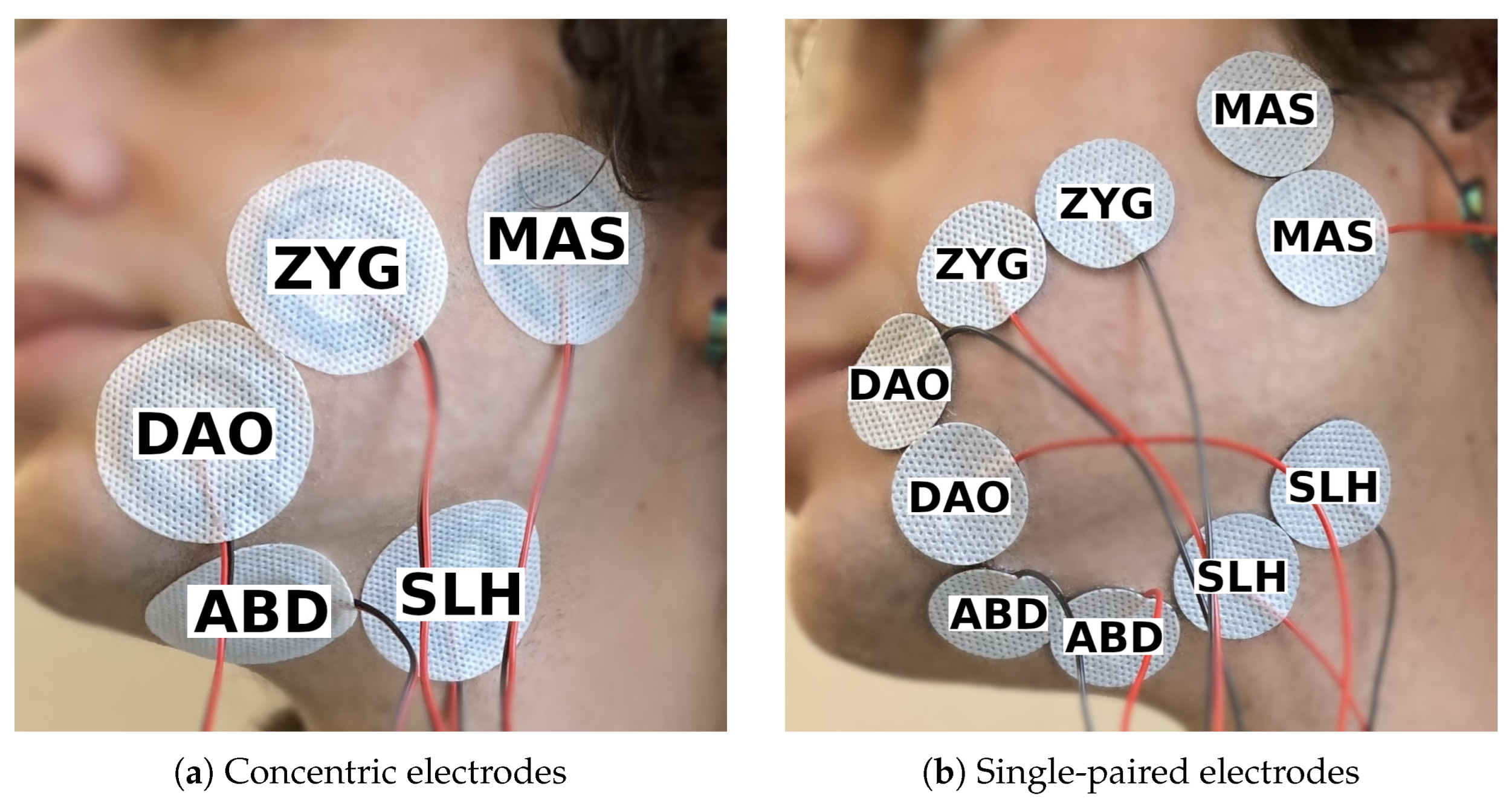
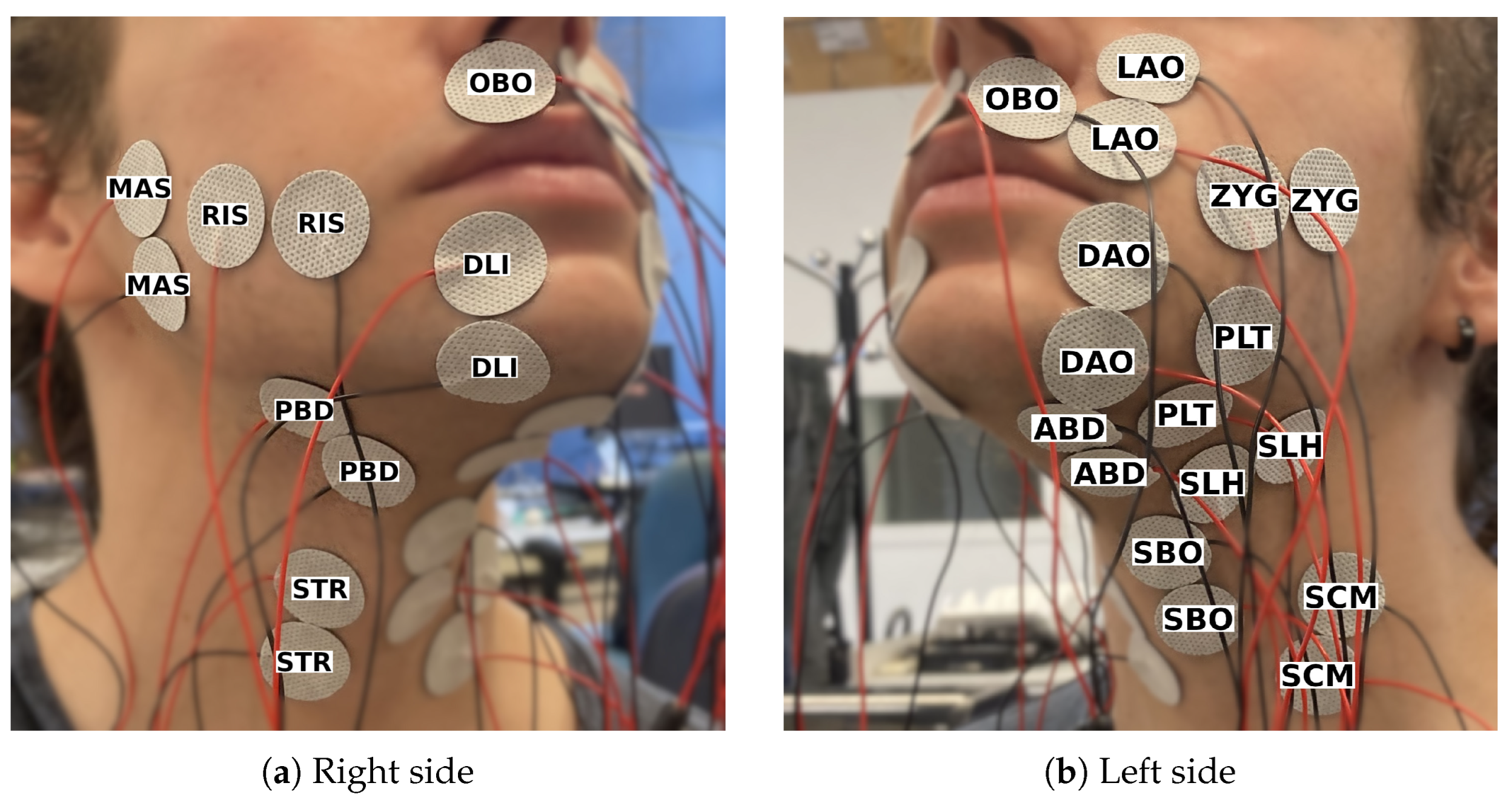
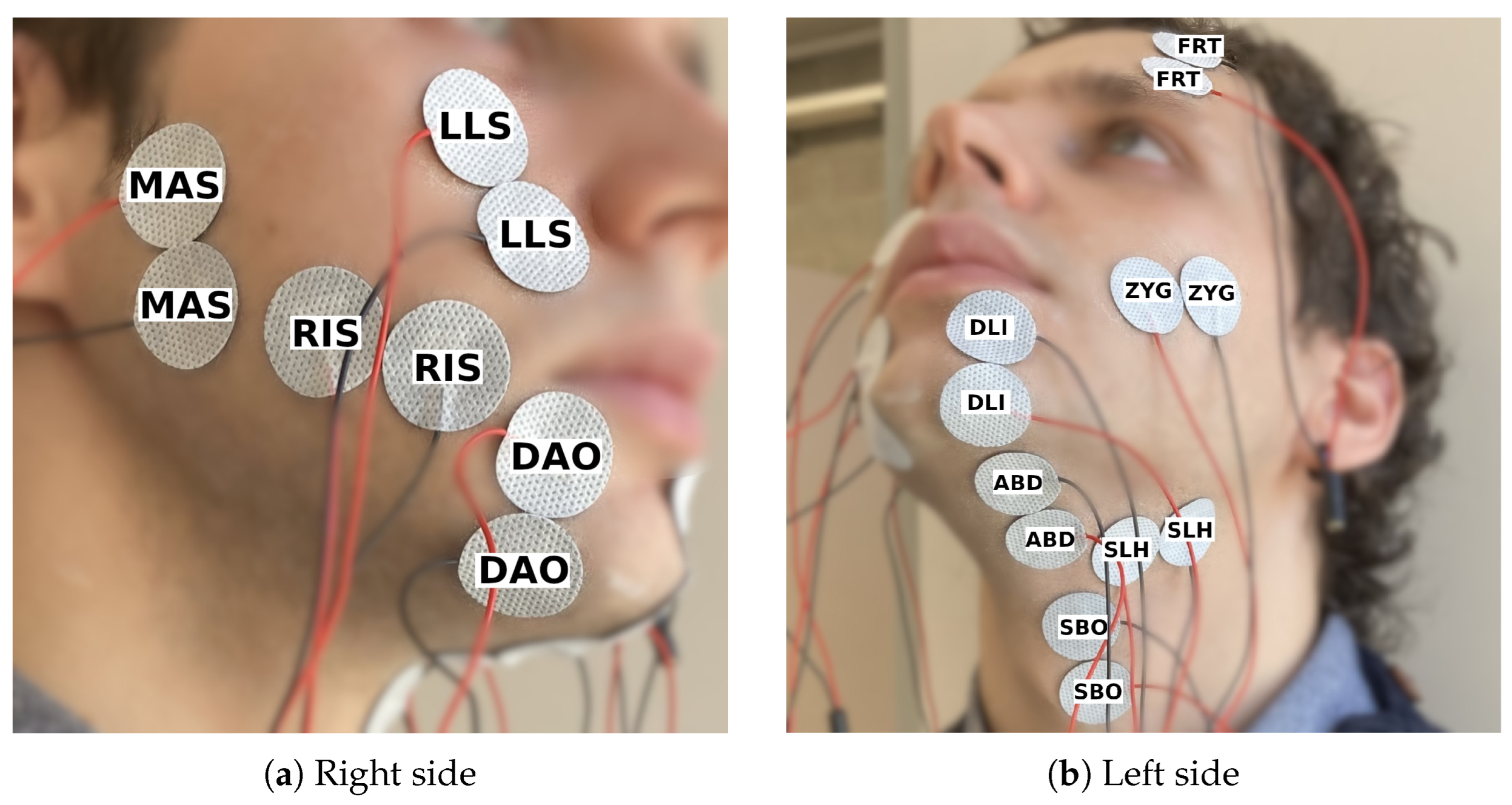
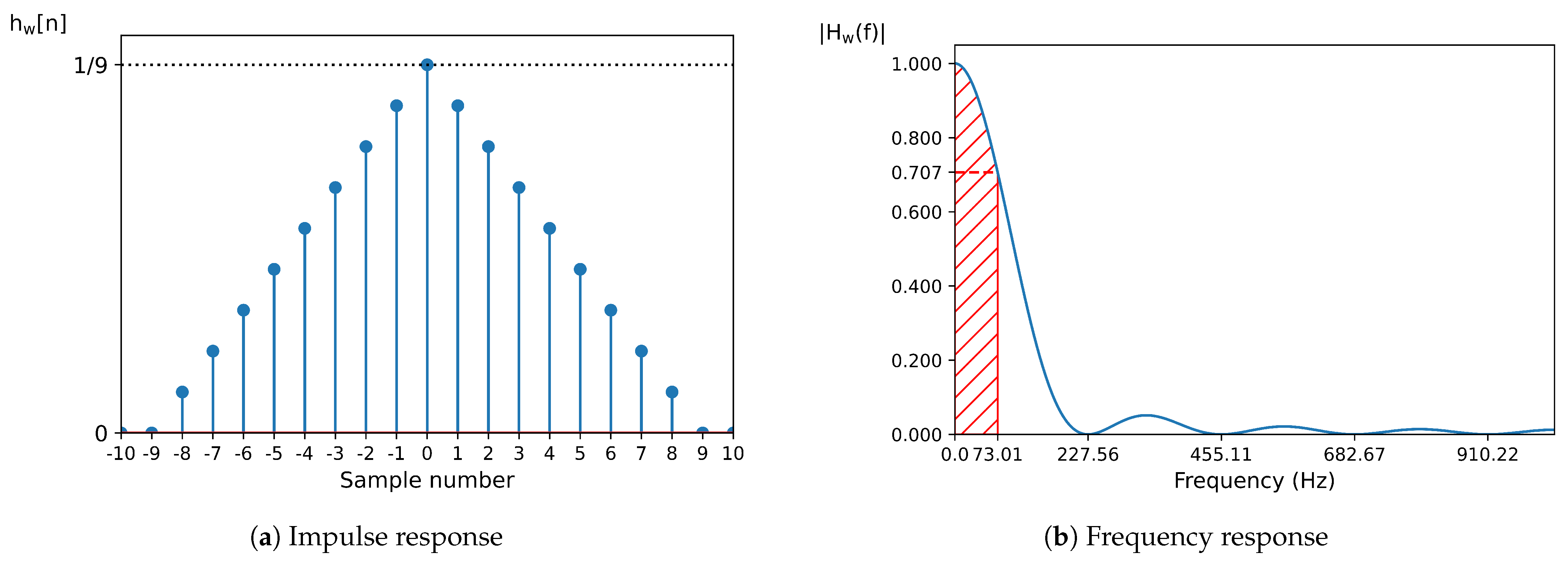
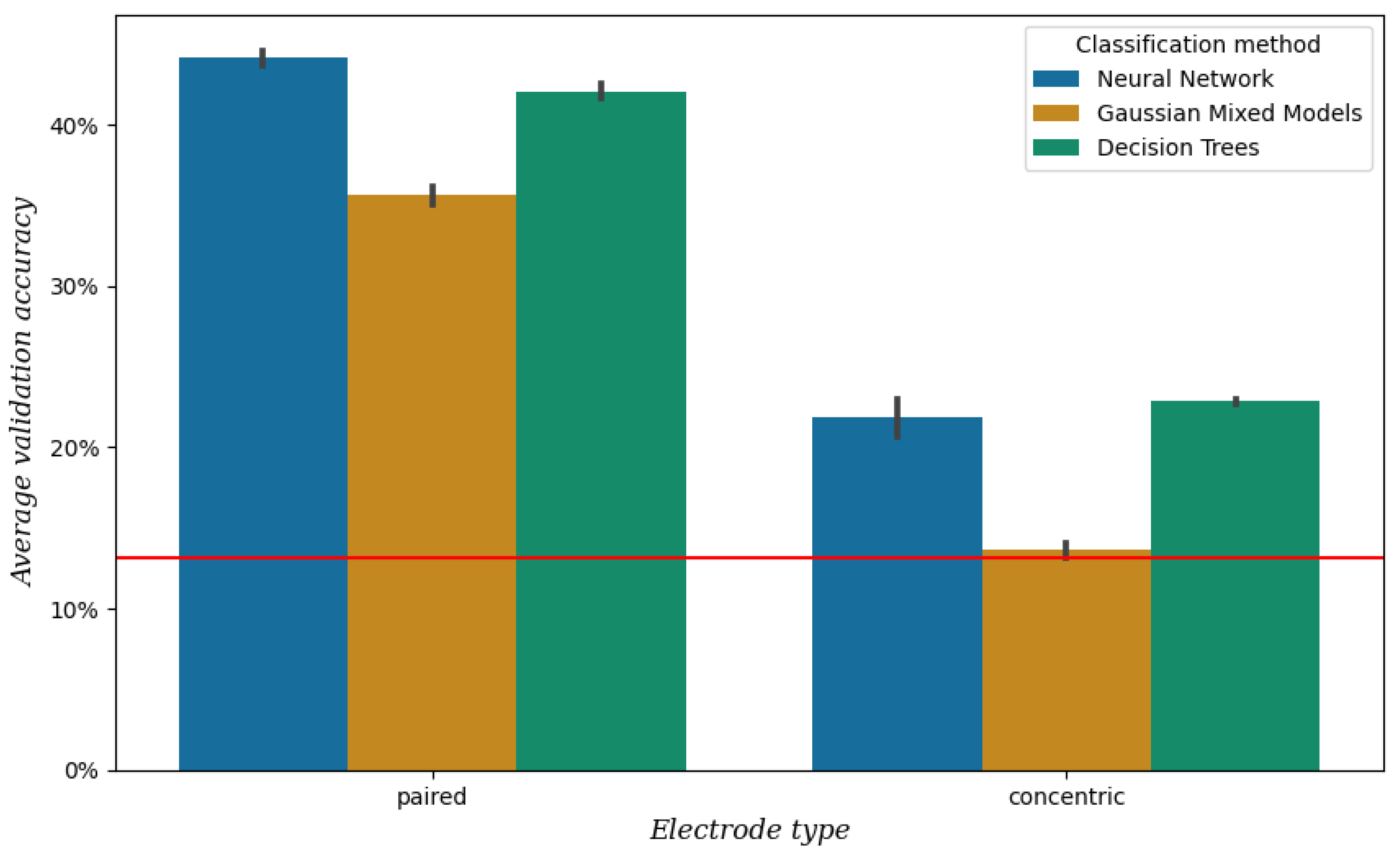
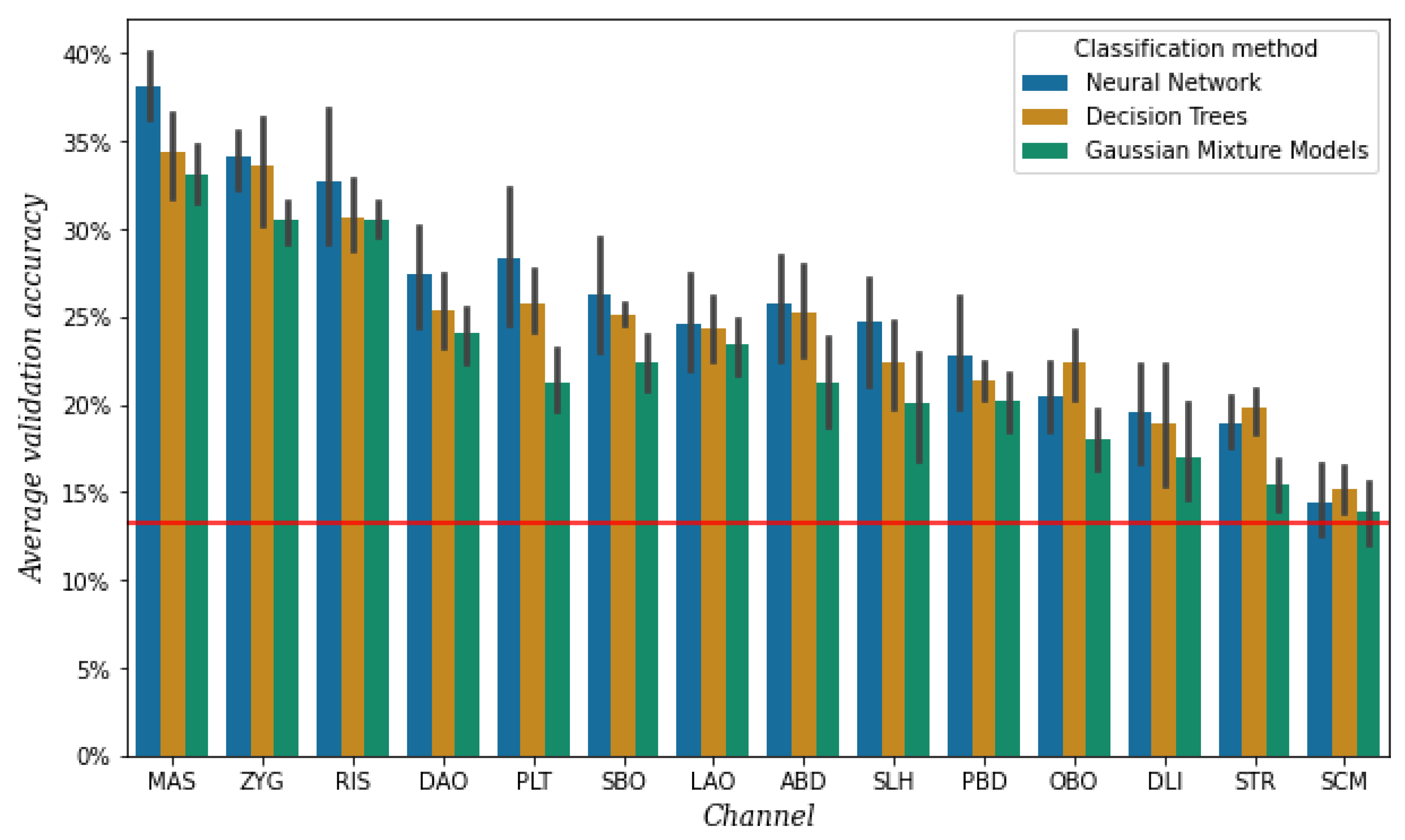
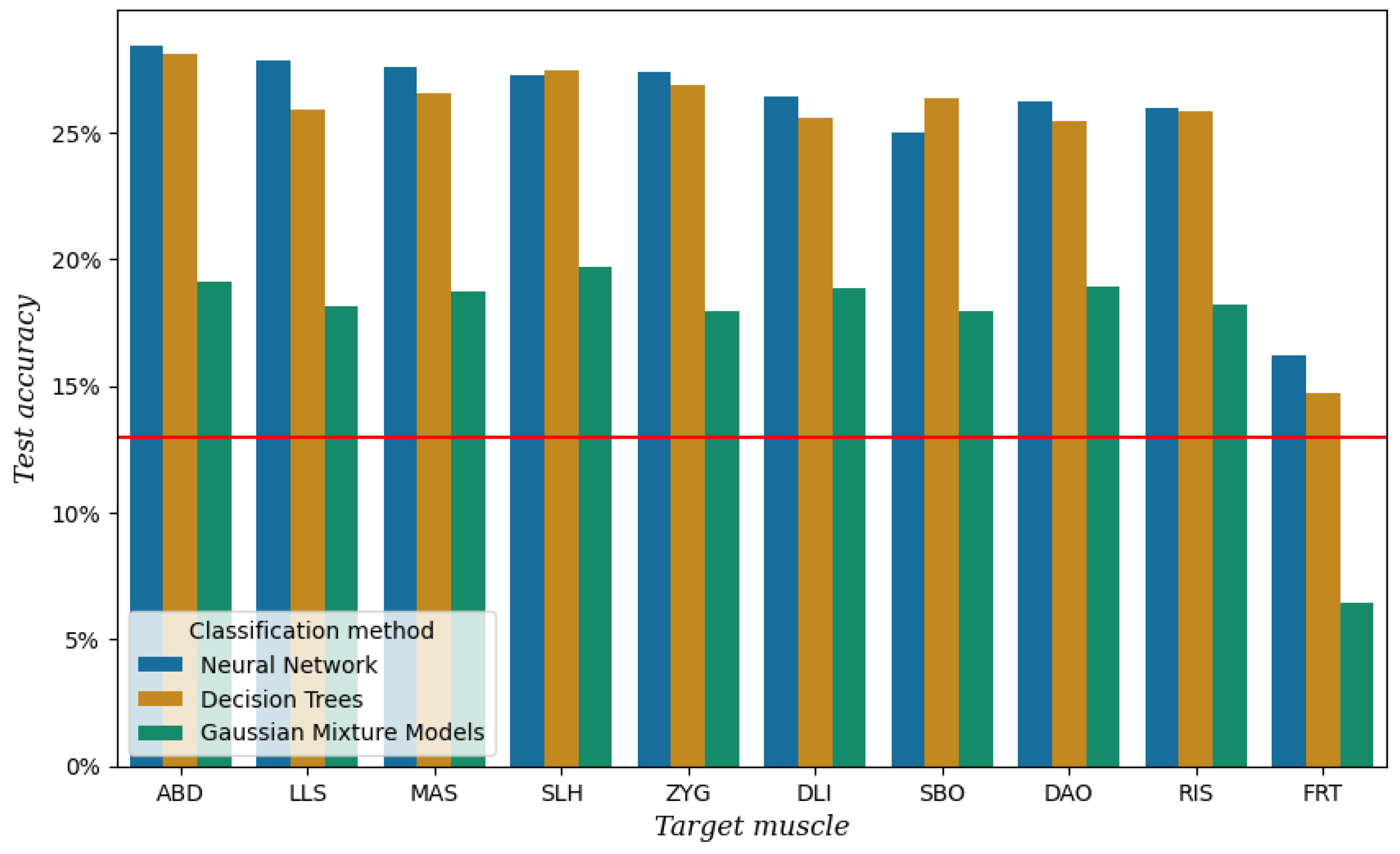
| Muscle | Session 1 | Session 2 | Session 3 | Final Setup |
|---|---|---|---|---|
| anterior belly of the digastric (ABD) | X | X | X | X |
| depressor anguli oris (DAO) | X | X | X | X |
| depressor labii inferioris (DLI) | X | X | X | |
| frontalis (FRT) | X | |||
| levator anguli oris (LAO) | X | |||
| levator labii superioris (LLS) | X | X | ||
| masseter (MAS) | X | X | X | X |
| orbicularis oris (OBO) | X | |||
| platysma (PLT) | X | |||
| posterior belly of the digastric (PBD) | X | |||
| risorius (RIS) | X | X | X | |
| sternocleidomastoid (SCM) | X | |||
| stylohyoid (SLH) | X | X | X | X |
| sternothyroid (STR) | X | |||
| superior belly of the omohyoid (SBO) | X | X | ||
| zygomaticus major (ZYG) | X | X | X | X |
| Electrode Setup | Corpus | Size of Train Set | Size of Test Set | |
|---|---|---|---|---|
| Session 1 | 5 paired | 250 sentences | 09:12 | 02:16 |
| 5 concentric | 250 sentences | 09:02 | 02:17 | |
| Session 2 | 14 paired | 105 CV x3 | 01:00 | 00:15 |
| Session 3 | 10 paired | 250 sentences x2 | 17:16 | 04:23 |
Disclaimer/Publisher’s Note: The statements, opinions and data contained in all publications are solely those of the individual author(s) and contributor(s) and not of MDPI and/or the editor(s). MDPI and/or the editor(s) disclaim responsibility for any injury to people or property resulting from any ideas, methods, instructions or products referred to in the content. |
© 2025 by the authors. Licensee MDPI, Basel, Switzerland. This article is an open access article distributed under the terms and conditions of the Creative Commons Attribution (CC BY) license (https://creativecommons.org/licenses/by/4.0/).
Share and Cite
Salomons, I.; del Blanco, E.; Navas, E.; Hernáez, I. Electrode Setup for Electromyography-Based Silent Speech Interfaces: A Pilot Study. Sensors 2025, 25, 781. https://doi.org/10.3390/s25030781
Salomons I, del Blanco E, Navas E, Hernáez I. Electrode Setup for Electromyography-Based Silent Speech Interfaces: A Pilot Study. Sensors. 2025; 25(3):781. https://doi.org/10.3390/s25030781
Chicago/Turabian StyleSalomons, Inge, Eder del Blanco, Eva Navas, and Inma Hernáez. 2025. "Electrode Setup for Electromyography-Based Silent Speech Interfaces: A Pilot Study" Sensors 25, no. 3: 781. https://doi.org/10.3390/s25030781
APA StyleSalomons, I., del Blanco, E., Navas, E., & Hernáez, I. (2025). Electrode Setup for Electromyography-Based Silent Speech Interfaces: A Pilot Study. Sensors, 25(3), 781. https://doi.org/10.3390/s25030781







